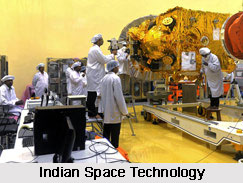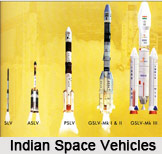 Space Technology in India can be traced back during 1960s. Space Technology in India began with the development of the Indian Committee for Space Research was established in 1960s by the Department of Atomic Energy. Subsequently it paved the way for a number of innovations in the field of Space technology and creation of the space centres in India. Space Technology in India has been largely used to develop advanced technology in field of agriculture, telecommunication, and weather forecasting for peaceful purpose while at the same time protects the nation from any unforeseen natural as well as man made calamities. It further helped Indian scientists to grow rocket technology by excelling propellant theory, rocket designing etc.
Space Technology in India can be traced back during 1960s. Space Technology in India began with the development of the Indian Committee for Space Research was established in 1960s by the Department of Atomic Energy. Subsequently it paved the way for a number of innovations in the field of Space technology and creation of the space centres in India. Space Technology in India has been largely used to develop advanced technology in field of agriculture, telecommunication, and weather forecasting for peaceful purpose while at the same time protects the nation from any unforeseen natural as well as man made calamities. It further helped Indian scientists to grow rocket technology by excelling propellant theory, rocket designing etc.
Space technology in India has been a dream innovation of India since the pre independence days. Before Independence modern space research was established by Scientist S.K.Mittra who made a number of experiments to carry out studies regarding the ionosphere in 1920s in Calcutta. This was developed further by Scientists like Chandrashekhar Venkata Raman and Meghnath Saha who contributed with practical application in space technology. After 1945 organised space research was mainly spearheaded by eminent scientists like Dr. Vikram Sarasbhai and Dr. Homi Jehangir Bhava. Their initial contribution has been in the field of cosmic radiation, high altitude and air bourn testing of instruments and deep underground experimentations. The space research got government support when Department of Atomic Energy was established with Homi Bhava as the secretary in 1950. This paved the way for establishing space centres and rocket launching centres in India that received a formal feature with establishment of Thumba Equatorial Rocket launching Centre in 1960s.
Space Technology in India took its first step with the establishment of Thumba Equatorial Rocket Launching Station in Thiruvananthapuram. Located between the coconut grooves, 832`34" N and 7651`32" E approx, this place was selected as the most ideal location as it was closer to the magnetic equator. Thumba Equatorial Rocket Launching Station which became operational in 1963 was mainly established for carrying out scientific experiments along with flight testing indigenous system. Till the establishment of Indian Space research organisation Thumba Equatorial Rocket Launching Station had established a number of infrastructural facilities. India had now established itself in aspects of Rocketry which includes rocket designing, rocket propellant, and rocket motor casting, and integration, payload assembly, testing and evaluating the system.
Space Technology in India along with Thumba Equatorial Rocket Launching Station now required another power station with more amenities. As such ISRO - Indian Space Research Organisation at Sriharikota was established which gave further impetus to space research programmes in India. Vikram Sarabhai and Satish Dhawan had been popularly known for pioneering the exploration activities buy launching a number of Satellites which mainly aimed at providing communication, meteorology, remote sensing and direct to home television broadcasting.
 Rocket Launching In India
Rocket Launching In India
Space Technology in India till date have made a number of attempts to launch sounding rockets .It began with the successful launching of Rohini family after it launched French Centura successfully. This continued with the launching of a number of Satellite Launch Vehicle SLVs which was a dream of Vikram Sarabhai. Finally India made are remarkable achievement by launching Aryabhata - India`s first master satellite which was aimed at growing advanced technology regarding the agricultural fields, weather forecasting etc. This was then followed by Bhaskara I which was followed by launching of Polar Satellite launching Vehicles popularly known as PSLV and GSLV. India made further progress by launching its programmes on INSAT which helped India to grow a nation wide direct to home telecommunication.
Indian Specialisation in space technology
Space Technology in India has mastered itself in some of the technological know-how. One such pioneering success which is often credited to India is its knowledge regarding Rocket propellants. It established a number of Propellant plants which included liquid propellants as well. It also developed the technology of Rocket designing which includes a number of processes. Indian innovations in the field of Space technology received a lot of appreciation the developed countries like UK, USA and USSR who not only supported India but also gave full help to introduce the knowledge In India. This became the biggest boost to the dreams of Indian Physicists.
Thus, Space Technology in India has been one of the biggest s scientific successes which have helped the underdeveloped nation to compete with rest of the world in providing latest scientific experiments.



















